Victoria remove bad sectors. Victoria HDD - a program for testing and diagnosing drives
Program Victoria HDD designed for comprehensive monitoring of drives. She does a quality check hard drive and can repair any identified defects.
Victoria HDD free download for Windows 7 (XP):
Size: 509 KB | Downloaded: 25416 times | File type: zip | Version: 4.46b
Key Features
- finding and eliminating defects in disk operation;
- display complete technical information about various storage devices;
- quickly obtain an accurate assessment of the current condition of the disks;
- built-in help system, as well as a file manager;
- searching for damaged contacts in the loop by testing the interface;
- automatic detection of controllers;
- several surface testing modes;
- assessing drive performance;
- cleaning the entire hard drive or its individual parts;
- copying data by sector;
- search for defects on the HDD surface, etc.
Pros and cons
- simple interface;
- work with SATA controllers,IDE;
- no installation required;
- high speed of work operations.
- work from DOS;
- The latest version of the program has not been updated for a long time.
Analogs of the program
HDDScan. A utility that can diagnose and test various information media. It finds all kinds of problems and errors, displays information about the device, and can change its individual parameters.
HDD Regenerator. A powerful application for restoring new and old hard drives whose operation has been disrupted due to bad sectors. In this program, you can correct the errors found and thereby optimize the operation of your computer.
MHDD. Hard drive monitoring program. It performs diagnostics at the lowest level, so it can find even the smallest glitches that are detrimental to operation. All found problems are stored in a log; the utility can clean the drive and remove bad sectors.
Operating principles
In order to check your hard drive for bad sectors and errors, launch the application and go to the “SMART” menu. For a comprehensive check, click on the “Get SMART” button.

After this, you will receive a comprehensive report that will show you the general condition of your computer.

This test does not go into detail, so for a more detailed analysis you can use the test to find and repair bad sectors. To do this, go to the “Test” item and click the “Start” button.
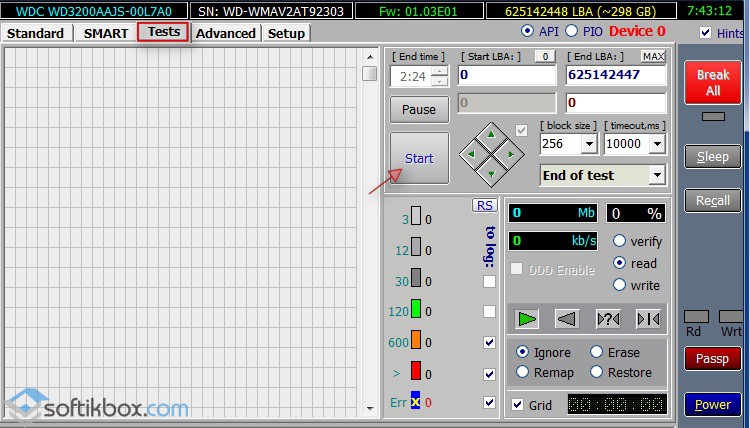
Once the process is complete, you will receive a detailed report with all the problems found.

If there are errors, highlight them on the grid and click “Repair”. If this doesn't lead to positive result, click on the “Clear” button.
Victoria HDD will find all the problems in the operation of your device’s drives and, by fixing them, will make it possible to get better performance from your PC.
Good day, dear readers, admirers and all other individuals!
Today we'll talk about diagnostics by the program Victoria(in the text below we will simply call her Victoria or Vika :)). The whole process is divided into 2 parts and 4 stage, and in general it is extremely simple if you follow the instructions.
This diagnosis is needed in order to search and identify his current health.
Unlike the once mentioned utility Chkdsk(“How to check a disk for errors” or “Chkdsk utility”), described below Victoria, is a representative of the class of programs that work with the equipment under test directly through the ports, that is, at the lowest level, which allows you to obtain the highest performance possible (that is, achieve higher quality, extensive and intelligible diagnostics), although it complicates the process of creating and using such BY.
Well.. Let's go?
We will consider two options for working with the program:
- Part 1: version 3.35 from external media.
- Part 2: version 4.46 from under Windows.
Stage I: installation and preparation for launching Victoria from external media
First, download Victoria (here is the version 3.5 , which is best suited for diagnostics outside the system).
After launching the program, you need to select our flash drive, specify the format file system and select the image we downloaded, approximately as shown in the screenshot below:
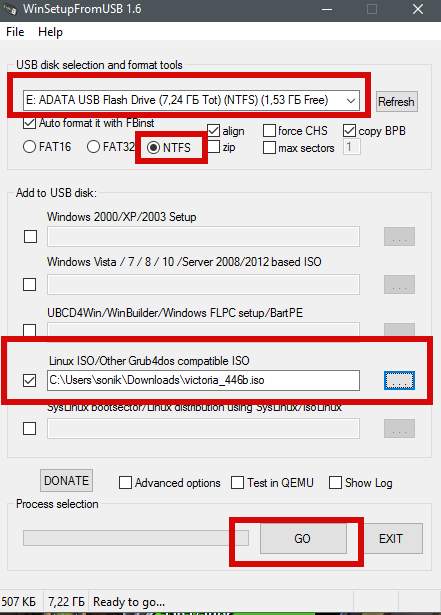
Attention!
All data on the flash drive will be deleted after clicking the " button Go", so it is recommended to first transfer everything from there.
Next, we need to boot from the disk/flash drive where we recorded the image. To do this, insert the disk into the computer, reboot, go to (button DEL or F2 at the earliest stage of booting the computer) and there we set boot from disk using the method described below (depending on what your BIOS).
Option 1. If your BIOS looks like this, then go first to Advanced Features
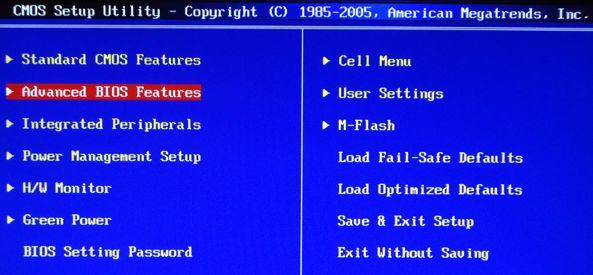
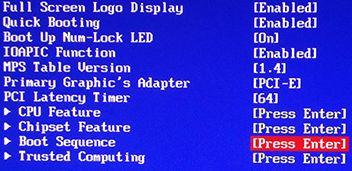
Where should you prioritize loading from CD/DVD drive just like in the picture.
Then exit BIOS through " Save and exit setup" and, if you did everything correctly, then wait until this program loads instead of the operating system.
Option 2. If your BIOS looks like this:
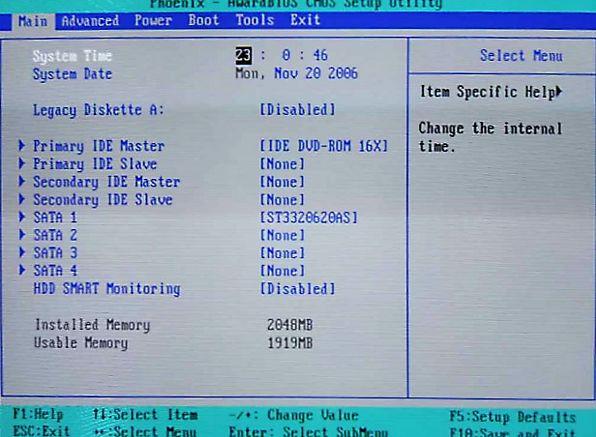
Then you just go to the tab Boot, and then set everything in the same way as in the pictures above (that is, as the first one, select boot from disk).
and you made not a disk, but a flash drive, then in BIOS You will need to select approximately the following option: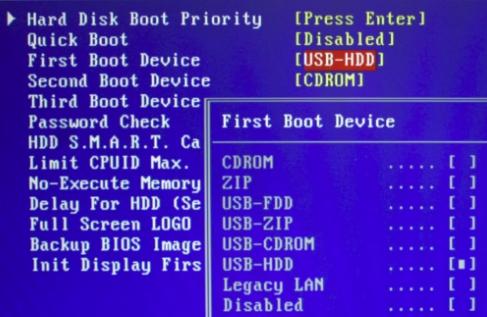
Or, let's say, like this:
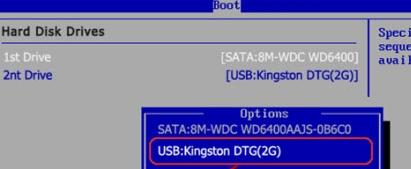
If you want to know more, want to learn this professionally and understand what is happening, then.
That is, the name of the flash drive itself and its volume or something like that may be indicated. In general, it’s not difficult to figure it out.
Having decided on this, save the changes and exit BIOS, starting to download Victoria from the media.
Stage II: download Victoria program and prepare for scanning
When downloading you will need to select one of the options Victoria. For desktop computer it will be Victoria for Desktop, for laptop Notebook, the remaining items load the shell DOS and file manager Volkov Commander, i.e. in normal cases they are not needed.
Program selection options:
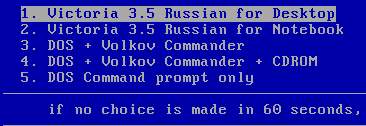
Perhaps, when you first start, you will need to select exactly the hard drive that you want to test (and not the one that is registered in the vcr.ini file - Secondary Master is indicated there in the distribution). To do this, press the key P.
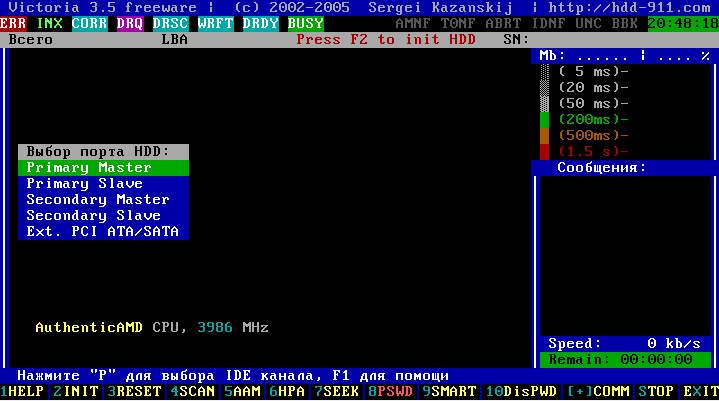
A menu with channel names will appear. The selection is made using the cursor keys " up" And " down". When you move the cursor, an indication (light bulbs) is displayed in real time, which allows you to judge the readiness HDD.
A working hard drive will always have 2 lights on: DRSC And DRDY(some may also INX). The error registers may have a red light on. AMNF, and the rest must be repaid. For more information on the purpose of indicators, see the end of the article. After placing the cursor on desired item must be pressed ENTER.

The last item of this menu is responsible for selecting the hard drive on the external (additional) PCI/ATA/SATA/ controller. After clicking ENTER The search for external controllers and hard drives on them will begin. Only actually present and serviceable hard drives in position will be detected MASTER, the system “will not notice” the rest. When each additional port is found, the table will display:
- Name of the ATA controller manufacturer (or its Vendor Code)
- Controller name (or its ID Code)
- Class: EXT / INT / RAID (external, internal, RAID)
- Port address (or a dash if it could not be determined)
- Name of the connected hard drive, if it is on the channel and is working
All found ports will be numbered. All you have to do is select the one you need by pressing the appropriate key and confirm Enter"ohm.
Note:
The program may not find hard drives on some controller models Promise. Next click F2 to “give” your passport.Passport HDD- this is information hard-wired at the manufacturer’s factory that characterizes the hard drive family and its individual characteristics.
Scanning works in close connection with the passport, receiving all the necessary parameters from it.
Stage III: Scan the disk for errors and problems
Now the most important thing.
To test the surface of the hard drive, press the key F4. Next, a menu will open where you need to set “Linear reading” and below “Ignore Bad Blocks”(Ignore bad sectors). The selection is made with the key "Space" or arrow keys “Right” And “Left”. The scanning window looks like this:
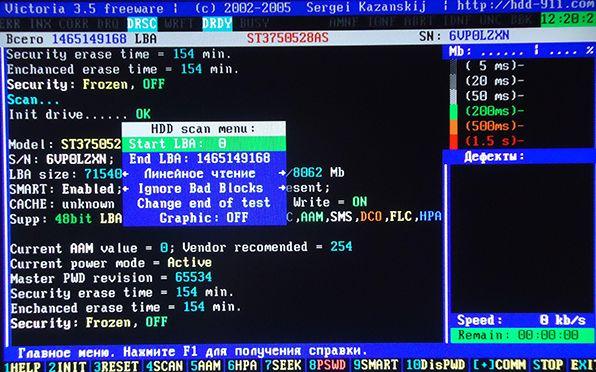
Attention!
In the third menu item from the top, actions such as “Record (erase)”, “Write from file” and in the fourth menu item “BB = Erase 256 sect” erase the information on the disk!
Now press again F4 to start scanning. All that remains is to wait for it to end.
At the end of the test, if you had no errors, you will see something like this:
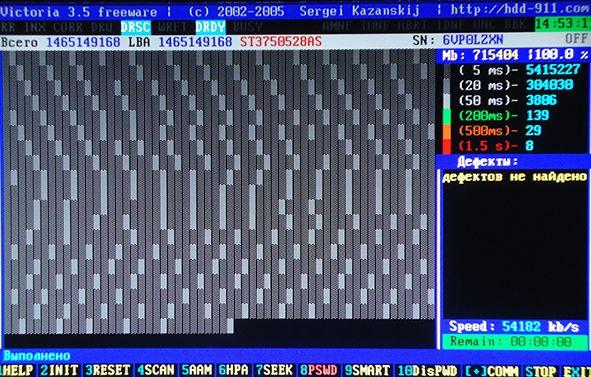
What should we focus on here? On the right there is a gradation of sectors from dark gray to red. The more orange and red, the worse it is. If the value of the red ones is especially high, then it’s probably high time to throw away the disc, especially if the list of defects is full (and not empty, as in the screenshot above).
What else is important to understand here:
- If the hard drive freezes due to a malfunction during scanning, the program waits about 16 seconds, after which it moves on to the next block, displaying the icon T(Timeout) in the scan field;
- Continuous delays indicate that hard drive does not respond to commands. In this case, you can try sending a reset command to its controller by pressing F3(Reset) directly during scanning, sometimes this helps;
- All possible defects and other problems will be described in the block " Defects" or " Messages" right;
- You can also check the interface. Its check is selected in the third menu item from the top, when you press the key F4"Scan", i.e. where you chose linear reading.
The purpose of the commands is described in sufficient detail in help system. So put pressure on F1 whenever you are experiencing difficulties.
Stage IV: Interface Check
Interface checking cyclically writes a data pattern to the hard drive's buffer memory, then reads from there and compares what was read with what was written. In this case, the reading time from the buffer is measured in the range from 64 to 500 mks.
This test clearly shows what multitasking of the firmware built into the hard drive means - the reading time for different cycles is different and depends on models of hard disk and its operating mode. If there is a discrepancy between what was written and what was read, a message is displayed indicating the time by the clock. The presence of such errors indicates a malfunction of the interface or buffer memory of the hard drive, and such a drive is considered potentially dangerous, since it can distort the information stored on it.
To obtain high reliability, you need to run this test for a long time, similar to computer tests. It is recommended to move during testing IDE cable to diagnose bad contacts, which will be immediately detected by the program.
Note:
Exit the program, button - X.
Leaving Victoria, you find yourself in " Volkov Commander", from which you can exit by pressing the key F10 and choosing " YES" accordingly. Then you get into DOS
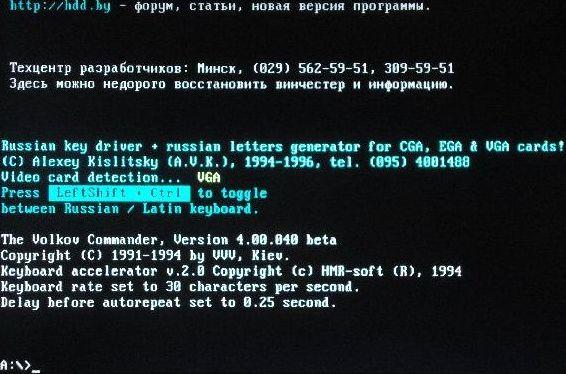
Where you can exit by clicking Control+Alt+Del. The computer will restart. Don't forget to remove the disk from the drive and return booting from the HDD.
Useful information on checking and diagnosing a disk through Victoria
Operating mode indication HDD and error codes based on indicator lights.
(Primary source - ATA/ATAPI standard)
- BUSY(Busy), - the disk is busy processing a command or is frozen. While this light is on, all other indicators are considered invalid and the hard drive can only respond to the “Reset” (F3) command;
- DRDY(Drive Ready), - the disk is ready to receive a command;
- DRSC(Drive Seek Complete), - the drive has successfully completed installing the head on the track. Outdated. On new hard drives, the assignment depends on the previous command;
- INX(Index), - lights up with each revolution of the disk. On some hard drives it is no longer used or may produce incorrect results;
- WRFT(Write Fault), - write error. Outdated. According to the new standard and, therefore, to new HDDs: "Device Fault" - device malfunction;
- DRQ(Data Request), - the disk is ready to exchange data via the interface;
- ERR(Error), - an error has occurred (you can find the error code in the error register).
Error registers:
- AMNF(Address Mark Not Found), - the sector cannot be read, usually as a result of a serious hardware problem (for example, on HDD Toshiba and Maxtor talks about a malfunction of the magnetic heads);
- BBK(Bad Block Detected), - a bad block was found;
- UNC(Uncorrectable Data Error), - it was not possible to correct the data with redundant code, the block was declared unreadable. May be a consequence of a violation checksum data, and as a result of physical damage to the HDD;
- IDNF(ID Not Found), - the sector is not identified. Usually it indicates the destruction of the microcode or lower-level format of the HDD. On working hard drives, this error occurs when trying to access a non-existent address;
- ABRT(Aborted Command), - the hard drive (disk) rejected the command as a result of a malfunction or the command is not supported HDD data(password, outdated or too new model etc.);
- T0NF(Track 0 Not Found), - it is impossible to recalibrate to the starting cylinder work area. On modern HDDs indicates a malfunction of the microcode or magnetic heads.
This minimum required, which is worth knowing and understanding. For everything else you need to use your brain, and questions can be asked in the comments or on ours.
Using Victoria 4.46b under Windows. Instructions for checking disks
Now let's talk about using the latter official version programs for Windows, namely 4.46 .
Having carefully studied SMART and the parameters in it, go to the tab Tests. Its functionality is generally similar to what we did in the first part of the article:
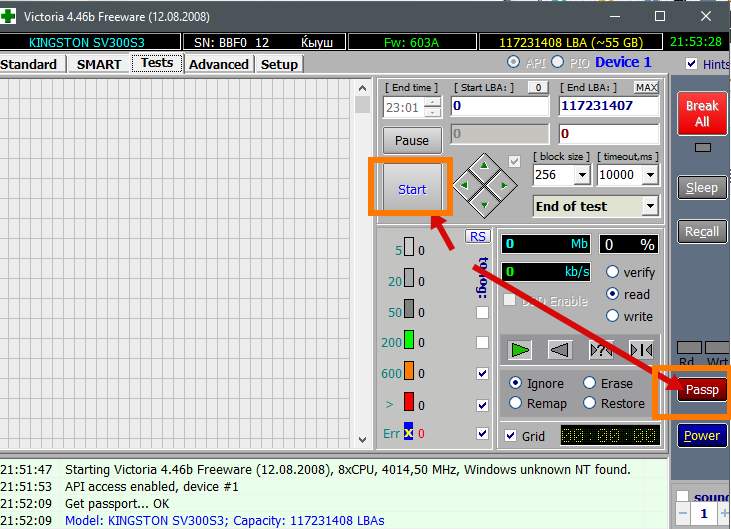
To run these same tests you will need to press the button Passp to get information about the disk that we will test (you can select it on the tab Standard, if you need another), and then Start.
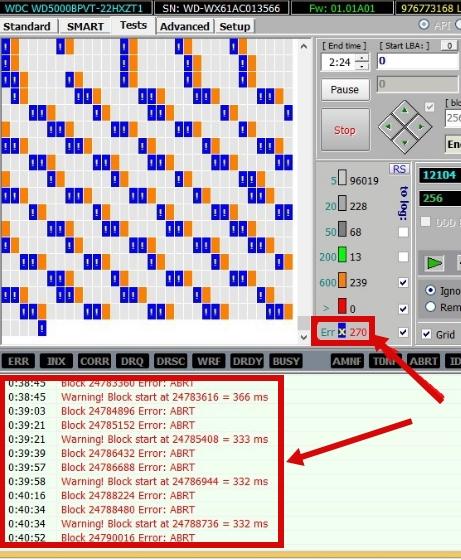
During the check, normal, faulty, problematic and other sectors will be identified, the number of which you can see both in the column on the right and in the log below (in particular, there will be more detailed information about the sectors of the beginning of a particular block, etc.). All that remains is to analyze all this and decide what to do with the disk next.
In a nutshell about working with the program from under Windows, perhaps that's all. If something is not clear, then first read the entire article, then look at the comments to it, and if something is still not clear, then, as mentioned above, contact us, for example, on the forum or in the same comments .
We move on to the afterword.
Afterword
This is how the pies are made.
Often such diagnostics are needed in case of appearance, tapping of the hard drive or any other suspicion that the problem incorrect operation(in particular, say, partial data loss) lies precisely in the HDD.
Stay tuned and all that stuff. You are always welcome here, including helping;)
PS: For the existence of this article, special thanks to our BSOD-to the master under the nickname “DJON0316”.
 Winchesters, like any other computer components, may break, malfunction or be damaged. In such cases, whenever possible, it is required hard restoration disk using special software. Thanks to their use, you can thoroughly check the disk and fix minor malfunctions.
Winchesters, like any other computer components, may break, malfunction or be damaged. In such cases, whenever possible, it is required hard restoration disk using special software. Thanks to their use, you can thoroughly check the disk and fix minor malfunctions.
Considering that most users use computers and laptops for simple everyday use, then, as practice shows, this is enough for efficient work for a long time yet.
In this article we will talk about one of these programs, Victoria HDD, designed to check your hard drive. Let's figure out what this utility is, how to use it, and what you can achieve with it.
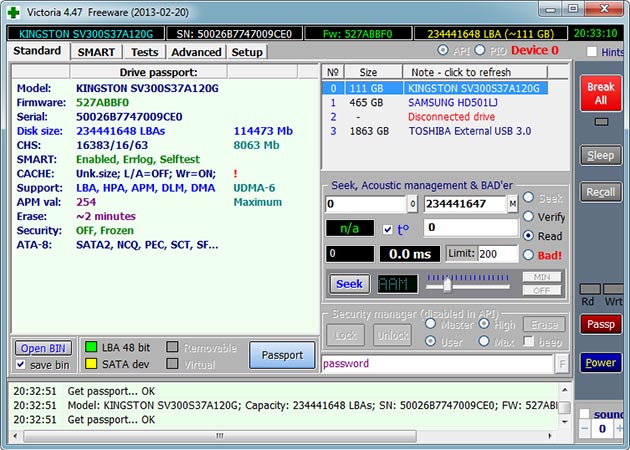
First of all, we can say that the Victoria program was created by a leading specialist from Belarus. It is absolutely free and is located in free access on the Internet. Thanks to its wide functionality and simple design Victoria is suitable for both beginners and professionals.
Victoria is suitable for everyone Windows versions, including Windows XP/7/8/10 and supports x32 and x64 bit platforms.
Functional modes
This program has several operating modes:
- API (using Windows OS tools).
- Offline mode via ports.
As for the first, it is the main one and has a number of possibilities. Its main advantage is its simplicity and convenience, which makes it accessible even to inexperienced users.
If we talk about offline mode, then he is more intended to work as a specialist. With its help, you can get the most accurate readings and conduct a thorough diagnosis of both external and internal hard drives. In addition, it has a more extensive set of recovery tools.
Program functionality
According to the information provided by the official website, this program For hard testing disk is capable of:
- Speed up your PC.
- Restore stable work operating system and individual programs.
To achieve such significant results, the utility has a positive effect on the HDD and provides:
- Replacement of defective sectors of the hard drive with spare ones.
- Elimination of bad sectors.
- Repair of damaged areas.
So, taking advantage of this software, you can restore the performance of the drive and extend its service life.
System recovery tools
Of course, you can use conventional recovery tools, and then the operating system itself will replace the damaged sectors with backup ones.

This is done by running a drive volume check, however, this type of replacement has its drawbacks:
- Works with the active volume exclusively in DOS mode.
- Does not provide the user with detailed information.
- Does not allow you to choose how to solve the problem yourself.
That is, standard tools do not have such wide functionality as third-party programs.
Without a doubt, Bill Gates created an excellent operating system. But think about how much standard programs you replaced. For example, Internet browser Explorer, Notepad or File Explorer. That is why checking and restoring the hard drive should be done using the Victoria program, and not built-in tools.
Working with the utility
Before you start working with Victoria program and present a guide on its use, I would like to clarify that the main language of the utility is English. However, on the Internet it can be found entirely in Russian; to do this, enter the corresponding phrase into the search.
Thanks to the support Russian language it is incredibly convenient to use, which cannot be said about others similar utilities. Download only the most new version, since it is the one that has all the tools necessary for work and contains a minimum of errors, if any, of course.
Download and launch
It’s incredibly easy to find a program on the Internet by entering the phrase “Download Victoria” in a search engine. You can read it there too detailed description. Next, select a reliable site, preferably one that has been previously verified, and download the utility from it to your PC.
The Victoria program does not require installation, since it will be in the form of an archive. Unzip it, go inside and you will see a single file “vcr447.exe”.

For your convenience, you can create a shortcut on your desktop.

Launch on a computer with the Windows 7, 8 and higher operating system installed exclusively as an administrator. To do this, click on the icon right click mouse and select "Run as administrator".
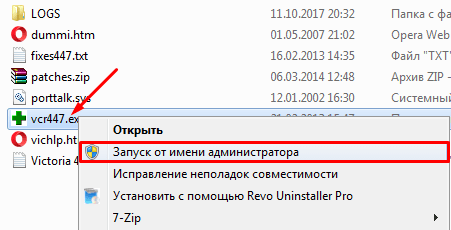
Before the program opens, several windows will appear on the screen:
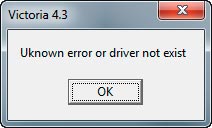
Don't worry, it's a simple call to PC repair experts. This is a warning that there is no driver to work with the ports. Just click “OK” everywhere, and Victoria will launch.
Getting started
To open graphical shell utility, you need to go to the “Standard” tab. All connected ones will be displayed on the right hard drives, select the one you want to check. Even if there is only one, click on it and all the data relating to it will be displayed on the left.

Next, go to “Smart” and click the “Get Smart” button. The table will display 242 parameters of your device. They are recorded from the first day of use of the drive, and the program reads them from the system.

The fifth point in the “Health” column deserves special attention:
- Green circles indicate disk sectors in excellent condition.
- Yellow color – indicators are not normal.
- Red circles indicate that the parameters are unacceptable.
We also need to say about the “Raw” column, where you can see the number of broken sectors of hard disk.
Test tab
Now you should go to the “Test” tab. The principle on which it is carried out HDD test, consists in measuring the duration of time from a request to receiving a response from sectors individually.

In process scanning hard disk, the program evaluates the checked sectors and graphically shows problem areas, indicating them with multi-colored rectangles.
Clusters are designated a certain color, which depends on its state:
- Gray ones are perfectly readable sectors.
- Green ones take longer to respond, but are in good condition.
- Orange ones take a long time to read. It is these sectors that slow down the disk. They are working, but very soon they will become unusable. Their number should not exceed 50 pieces.
- Red – damaged sectors “bad blocks” that cannot be considered and cannot be restored. If you have such sectors, you should think about changing the hard drive.
- Blue with a cross – reading sectors causes a failure. The information contained on them cannot be . Such sectors need to be re-partitioned so that the HDD does not use them during operation. This is done by using the remap function, which we will talk about later.
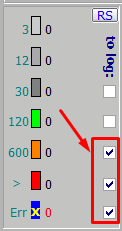
Actions according to the modes will be applied to those sectors in front of which you check the boxes.
Operating modes
We can talk about four modes of operation that the Victoria program has:
- Ignore – normal diagnosis of hard disk without affecting bad sectors.
- Remap – replacing bad sectors with backup ones.
- Restore - restoration programmatically damaged sectors "bad blocks".
- Erase – overwriting bad sectors. The function is most effective when there are software bad blocks on the hard drive, especially when there are a lot of them and it is required maximum speed recovery. When using this function, all information is erased.

The last point deserves special attention - Erase. It should be tested only when the “Remap” and “Restore” modes do not bring results, but before that it is advisable to save all the information on the drive.
Reserve sectors
The operating system allocates reserve place on every hard drive. Often this is the slowest section of about 8% at the center of the hard drive.
If bad sectors appear, the system transfers the information available on them to the reserve area. This happens when scanning the HDD for errors starts standard means Windows or by using third-party software.
Diagnostics
After you select a mode and check the boxes next to the rectangles, you can click “Start”. When using for the first time, it is not recommended to change the default settings. In this case, the usual operation will be carried out, without applying any actions to the damaged sectors.

If you follow the points in our step by step instructions, but after starting the scan nothing happens, this may be due to the fact that you did not select the hard drive in the “Standard” tab. In this case, you need to go back and do this.
The diagnostic process can be observed visually. IN earlier versions Victoria programs displayed the sectors being checked in the form of a grid.
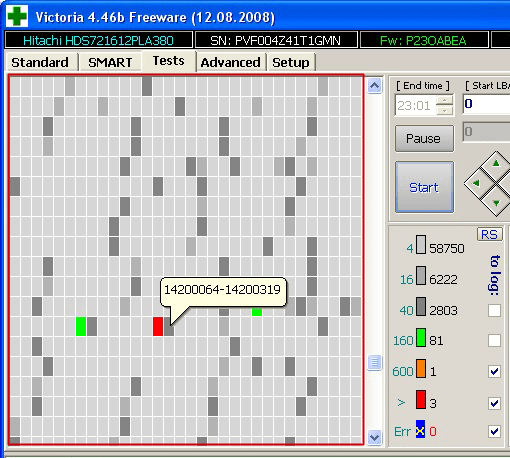
However, this overloaded the processor when presence of hard large capacity disk. That is why, starting from version 4.47, it was decided to switch to visualization using a graph. It can be seen just a few minutes after the start of the diagnosis.

In both versions it can be disabled by unchecking the “Grid” checkbox.

Process HDD testing can last quite a long time, it all depends on the capacity of your drive. It is also not recommended to use a computer during the test, otherwise the results may not be accurate.
Buttons
After scanning starts, the “Start” button disappears, and “Stop” appears instead, by clicking on which you can stop the scan.
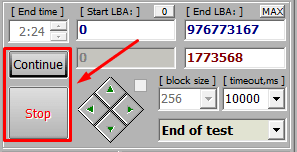
Also, for the convenience of users, there is a Pause button, with which you can pause the scanning process, and a “Continue” button to continue it from the same place where it was stopped.
Before checking hard disk, you must disable all programs. If this is not done, then the indicators may be inaccurate, and the number of sectors orange color will increase significantly, since some of them will be used by running utilities.
Is it possible to save the drive with Victoria?
Using the Victoria program, you can replace about 8% of bad sectors, correct errors and unsatisfactory performance of sectors in a volume if this happened due to system failures. Of course, Victoria is unable to fix physical damage to the hard drive.

If you cure sectors that can be corrected and rewrite the remaining ones to reserve, then something like this treatment of hard disk will significantly increase the duration of its operation. In this case, it should appear in the form additional device, while the operating room Windows system needs to be placed on a good storage device.
As for analogues, it has them, for example the same HDD Regerenator, MHDD. The functionality of the first is quite limited, while the second program practically duplicates Victoria and works only under MS-DOS.
Detailed video lesson
How to use the Victoria HDD program
